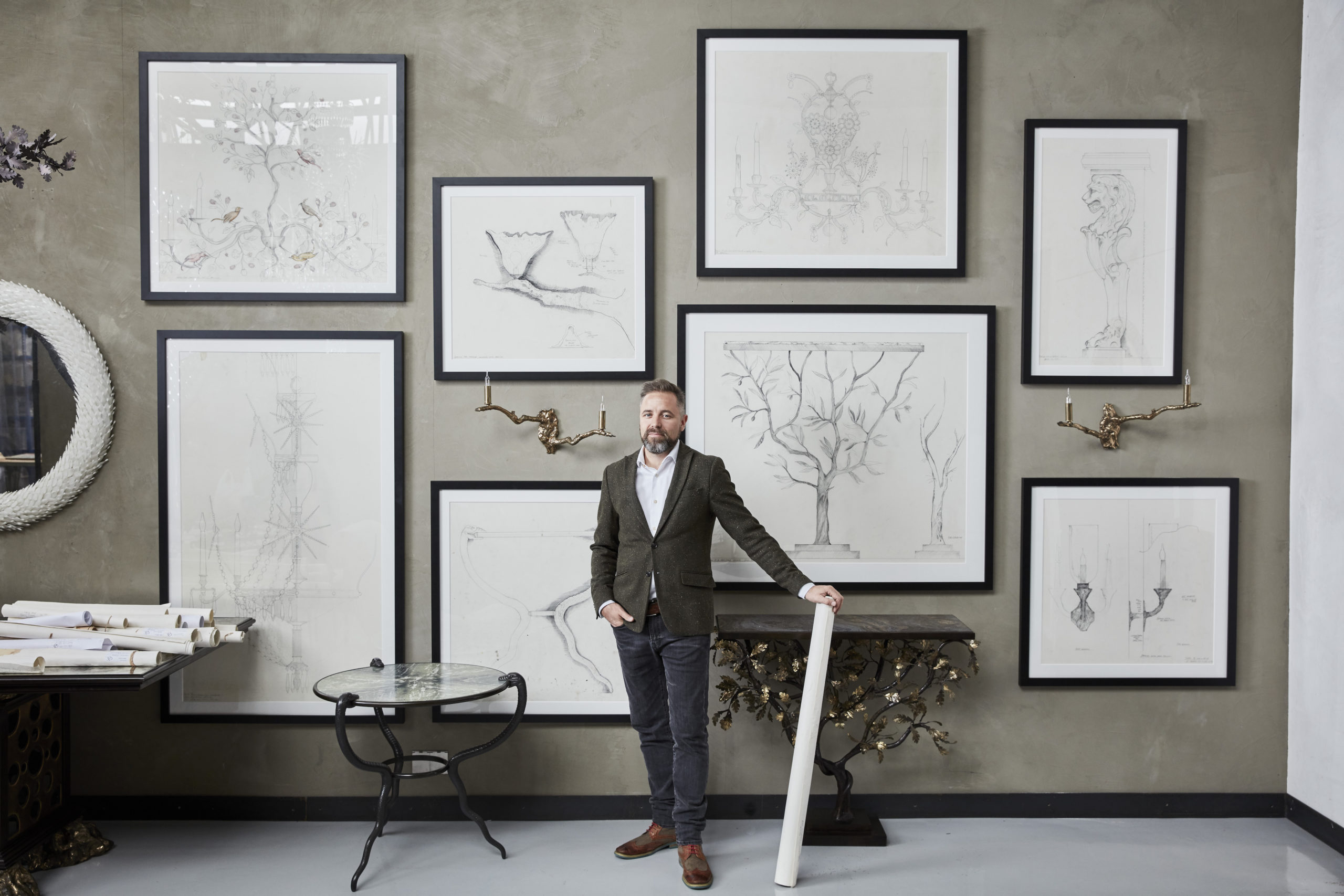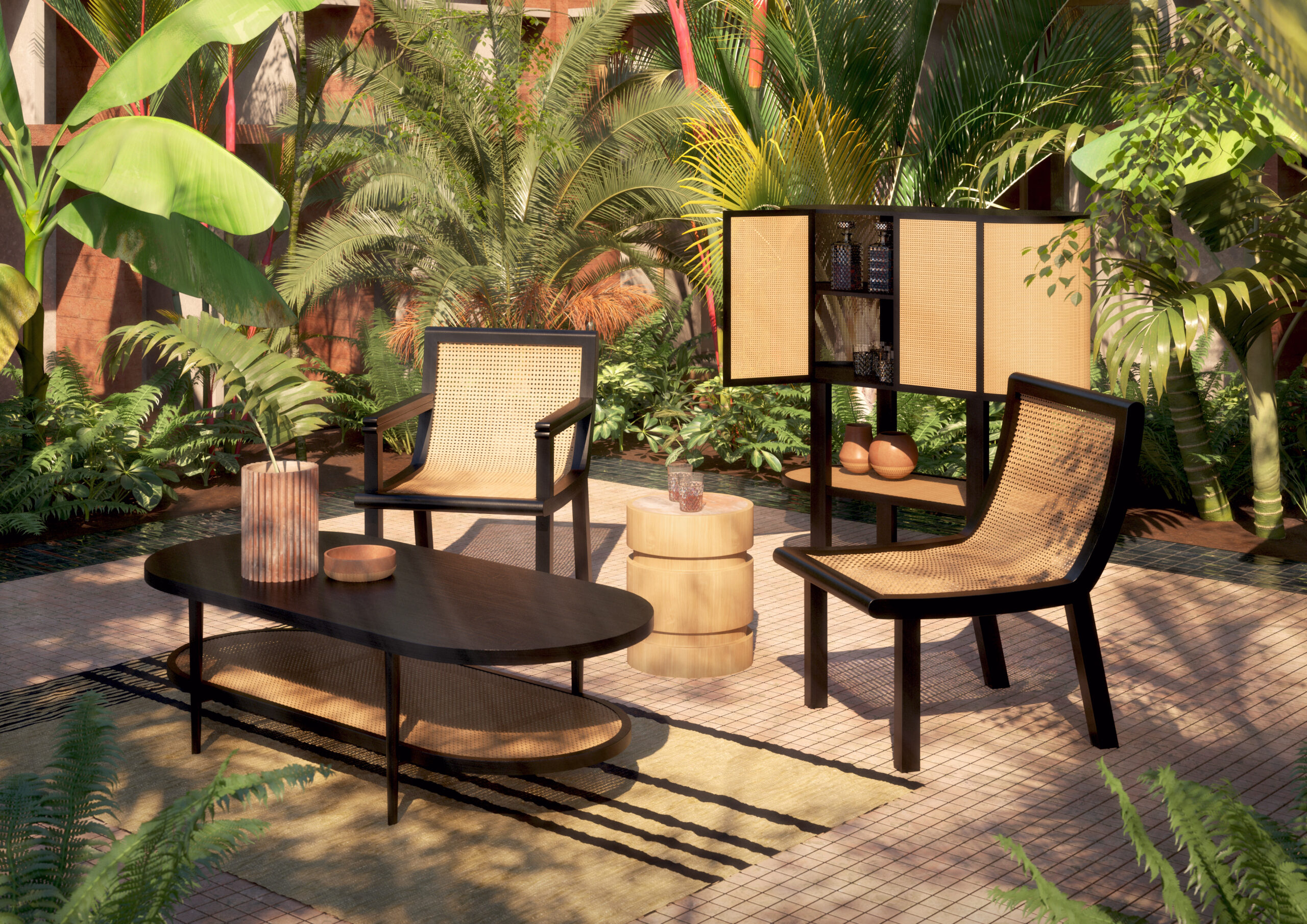With the past year forcing the adaptation of working habits and company structures, the onset of the digital world has accelerated, allowing us to function and perform while movement and travel are disrupted. Across the interiors world, showrooms have now become accustomed to exhibiting digitally, presenting new collections and works to a virtual audience. Thanks to innovative platforms and studios, 2D and 3D digital renderings have helped viewers and customers to visualise spaces and products without the need to create objects or sets physically.
While this has provided a unique experience throughout a challenging period for the design world, many feel this movement is here to stay, negating the need for in-person appointments and trade fairs. On one hand, reducing the logistical impact of such events could present a more sustainable future for the design world, however, will our desire for tangibility and a tactile experience be reignited as society opens back up?


When speaking with Studio Wireframe, a London-based studio creating digital products from rendered images to complete immersive environments which explore objects, spaces and architecture, they believe such tools can influence the narrative of a project before it is even realised. With a team made up of actively practising junior architects, they can look at every project from both a physical and digital perspective. “Knowing that in the digital world imagination is no longer bound by laws of physics but merely personal skills,” says co-founder Uday Berry, “we believe that the unbound creative influence of digital representation will inspire unexpected and exciting architecture, products and spaces in the future.” This was the motivation that inspired the birth of the studio in September 2020, alongside a response to the rise in demand for such skillsets over the last 12 months.
We believe that the unbound creative influence of digital representation will inspire unexpected and exciting architecture, products and spaces in the future – Uday Berry, co-founder, Studio Wireframe
“During the past year with shops shut, virtual media has taken on the responsibility to convey and represent brands as physical retail used to,” Berry continues. “Companies employ rendering studios like us in an attempt to capture their brand ethos, rather than just to represent a product or space.” For instance, the studio worked with furniture designers Kam Ce Kam for London Design Festival 2020 to create a world in which their Indian-inspired pieces would live. The result was an animation where the fields of architecture and furniture design met, in a Le Corbusier-inspired pavilion, capturing the collection’s aesthetic. The animation achieved a result that wouldn’t have been possible physically, or financially, yet showcased the collection in a way that represented it authentically. Kam Ce Kam’s founder, Jehanara Knowles, felt the collaboration enhanced what could have been achieved in the flesh. “It is a great way to transport the pieces to unique environments in a more economical and environmentally-friendly way,” she says. “It helped our clients to envision the pieces in different environments. If we had produced a shoot physically, we would have been more limited due to location availability and budgets.”

While designers are confident digital involvement will not replace the physical experiences of a pre-pandemic world, many can see the enhancements it will make, merging to create stimulating ‘phygical’ moments in the future of retail; a term many brands are already adopting. French glassmakers Lalique are an example of a company successfully adopting an immersive digital strategy to present new collections with a revolutionary approach. While steeped in heritage, the brand is in touch with the future, recently launching the ‘Lalique Dream Palace’: a virtual destination presenting its spring/summer 2021 decorative objects and jewellery collections, in collaboration with sculptor Nic Fiddian-Green and Pierre-Yves Rochon. “Lalique moved quickly as a business to provide clients across the world with an immersive, imaginative and creative virtual experience that was designed to be enjoyable and entertaining whilst bringing the products to life,” explains Alexia Ashworth, the company’s director of marketing. “While it doesn’t replace face-to-face interaction, the two can be complementary in reaching a wider audience at a faster pace. We have learnt a lot during the past year, and we will work hard to ensure our virtual events will improve. Going forward, we hope to merge both avenues with Lalique’s hospitality, and therefore provide the best customer experience possible.”
While virtual experiences don’t replace face-to-face interaction, the two can be complementary in reaching a wider audience at a faster pace
Alexia Ashworth, director of marketing, Lalique
When specifying for projects, interior designers find the use of visual renders can also cut out unnecessary back-and-forth within the early stages. However, many still prefer traditional methods of specification, such as hand-drawn layouts and plans. Interior designer Sophie Elborne, creative director of Kitesgrove, values the importance of this skill within her design practice. “Drawings help to fully portray the living spaces and bespoke pieces I commission,” she says. “I often gift clients sketches of their home at the end of the project too. For me, this is added value and a personal touch I can provide.”
Chris Cox, creative director of Cox London, feels the same: “I have always drawn to help visualise the products we create. I frequently make 1:1 hand drawings for the team to work from in production.” This part of the process remains a valued part of the packages both organisations present and one which they will strive to retain.

As we look towards a post-pandemic world, the real question lies in whether digitally produced images will eventually replace the physical creation and styling more commonly used today. Lucy Gough, who works as an interior stylist for many brands across the interiors world, understands the rising threat of computer-generated imagery to her industry sector. However, she feels nothing can ever replace the personal touch a stylist can bring. “Sitting behind a computer screen would eliminate that artistic level of styling that brings a shot to life,” she says. “Every shoot I style and direct is concepted very clearly before arrival, but once I’m on set I become a ‘bowerbird’ and find interesting and beautiful items in the location house or garden, which end up being used and help add a certain magic to the final images.”
While we cannot deny the dynamism that digital representation can offer, it is clear it must co-exist with the physical world, rather than cancelling it out entirely. “Even in creating a digital render,” Gough continues, “there will always be a need for an art director or a stylist. The person behind the computer most likely won’t have this experience, so the need for a physical creative team on a consultative basis is critical.”
So, if creating an imaginary, immersive environment is of interest, never forget to enlist the assistance of a physical team in guiding you to create a result that doesn’t disconnect you from your audience. Blending the two worlds together in a thought-provoking, future-focused yet sensitive outcome, is what can be seen as a successful transition to the ever-evolving digital design world we are becoming familiarised to.
Effect Magazine is brought to you by Effetto



